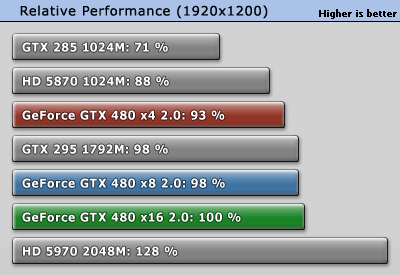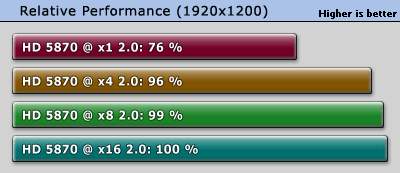- Sep 5, 2003
- 19,458
- 765
- 126
I. Computerbase - (Click Next after Test Setup for a full review)


II. TechPowerUp - Nvidia PCI Express 2.0 scaling (x4, x8, x16)


III. TechPowerUp - AMD PCI Express 2.0 scaling (x4, x8, x16)


III. Toms Hardware - PCI Express 2.0 scaling x8 vs. x16


IV (a). HardOCP - GTX 480 SLI PCIe 2.0 Bandwidth Performance - x16/x16 vs. x4/x4
IV (b). HardOCP - GTX 480 SLI PCIe 2.0 Bandwidth Performance - x16/x16 vs. x8/x8
IV (c). HardOCP - SLI & CFX PCIe 2.0 Bandwidth Performance - x16/x16 vs. x16/x8
V. Legion Hardware - P67 chipset 16x/8x vs. 16x/4x. Discussion thread here.
Conclusion: Soon Ivy Bridge will arrive with PCIe Gen. 3.0. However, based on modern cards and performed testing thus far, the time has not come to declare PCIe 2.0 8x/8x (or even 16x/4x) obsolete just yet. Most of these reviewers found that we have a lot of usable PCIe 2.0 bandwidth for single cards even at PCIe 2.0 x4, and certainly at PCIe 2.0 x8 with multi-GPU video card configurations. You may find a 5-7% difference between PCIe 2.0 x4 and x16 and probably around 2-3% between x8 and x16.
*** Most of you already know these findings. I figure we can consolidate a lot of PCI Express 2.0 scaling reviews into this one thread. Feel free to add any more reviews as they spring up. I'll update this thread when PCIe 3.0 reviews with next generation of cards pop up. ***


II. TechPowerUp - Nvidia PCI Express 2.0 scaling (x4, x8, x16)


III. TechPowerUp - AMD PCI Express 2.0 scaling (x4, x8, x16)


III. Toms Hardware - PCI Express 2.0 scaling x8 vs. x16


IV (a). HardOCP - GTX 480 SLI PCIe 2.0 Bandwidth Performance - x16/x16 vs. x4/x4
IV (b). HardOCP - GTX 480 SLI PCIe 2.0 Bandwidth Performance - x16/x16 vs. x8/x8
IV (c). HardOCP - SLI & CFX PCIe 2.0 Bandwidth Performance - x16/x16 vs. x16/x8
V. Legion Hardware - P67 chipset 16x/8x vs. 16x/4x. Discussion thread here.
Conclusion: Soon Ivy Bridge will arrive with PCIe Gen. 3.0. However, based on modern cards and performed testing thus far, the time has not come to declare PCIe 2.0 8x/8x (or even 16x/4x) obsolete just yet. Most of these reviewers found that we have a lot of usable PCIe 2.0 bandwidth for single cards even at PCIe 2.0 x4, and certainly at PCIe 2.0 x8 with multi-GPU video card configurations. You may find a 5-7% difference between PCIe 2.0 x4 and x16 and probably around 2-3% between x8 and x16.
*** Most of you already know these findings. I figure we can consolidate a lot of PCI Express 2.0 scaling reviews into this one thread. Feel free to add any more reviews as they spring up. I'll update this thread when PCIe 3.0 reviews with next generation of cards pop up. ***
Last edited:


